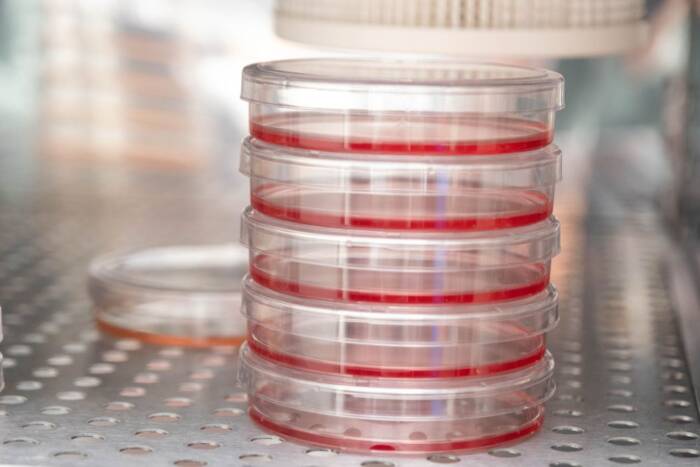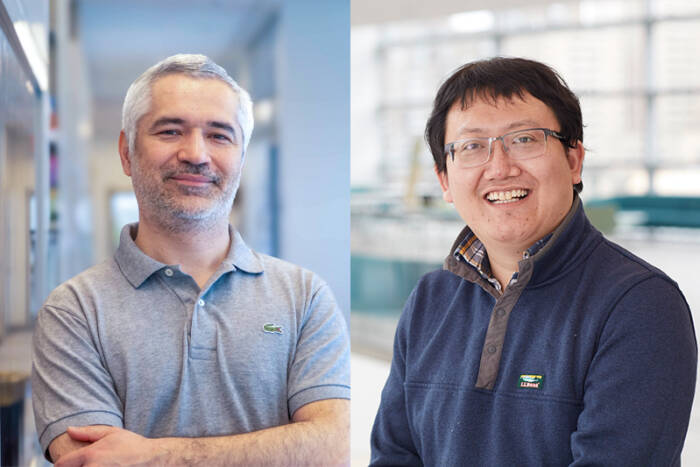From creatures of the dark to photosynthesizing green beings
How plant seedlings respond to light

A protein called COP1, working together with proteins called LAF1 and SPA1, helps seedlings flourish in the light. Using a combination of fluorescent tags and confocal microscopy, Rockefeller University researchers showed that COP1 and LAF1 co-localize to the same discrete substructures, called nuclear bodies, in the plant cell's nucleus (far-right panel). COP1 attaches to LAF1 and signals the cell to chew LAF1 up via a process known as ubiquitination.
A plant born into darkness, underneath a blanket of soil and leaves, will grow long and thin, its spindly stem stretching up towards the hidden sun. When at last it reaches the light, the plant will sprout green leaves, thicken its stem and begin to breathe – a coordinated effort involving the switching on of hundreds of genes. Just how light triggers such a grand developmental plan, called photomorphogenesis, has been further elaborated by Rockefeller University researchers.
In the June 26 issue of Nature, Nam-Hai Chua, Ph.D., and colleagues report how a protein called COP1, working together with proteins called LAF1 and SPA1, helps seedlings flourish in the light.
“Light signaling in plants has been studied for years, yet we are just now beginning to better understand the molecular mechanics underlying this fundamental process,” says first author Hak Soo Seo, Ph.D., a postdoctoral fellow in the Laboratory of Plant Molecular Biology, headed by Chua at Rockefeller. Other authors of this paper include Rockefeller scientists Jun-Yi Yang, Masaki Ishikawa, Cordelia Bolle and Maria L. Ballesteros.
Over a decade ago, scientists discovered that light triggers photomorphogenesis in plants not by directly turning on genes that code for photomorphogenic proteins, such as those needed for leaf formation, stem-shortening and photosynthesis, but by disabling a major suppressor of photomorphogenesis – COP1. This realization came about in 1992 after researchers found that mutant plants lacking COP1 will grow in the absence of light.
Since then, the details of COP1’s role in the cell have remained obscured, though the bigger picture is somewhat known. Scientists propose that, in the dark, COP1 patrols a plant cell’s nucleus for photomorphogenic proteins, and somehow causes their destruction. When sunlight finally appears, COP1 is thought to be redirected to the cell’s main cytoplasmic chamber, thereby freeing the photomorphogenic proteins in the nucleus from COP1’s authoritative hand. No longer targeted for elimination, these proteins accumulate and begin to set photomorphogenesis in motion.
In the new Nature paper, the Rockefeller researchers describe a biochemical mechanism by which COP1 specifically suppresses photomorphogenic proteins. They show that COP1 itself attaches to a major photomorphogenic protein called LAF1, discovered by Chua and colleagues last year, and signals the cell to chew it up via a process known as ubiquitination. In ubiquitination, unwanted proteins are tagged with small proteins called ubiquitin, which flag the proteins for destruction by cellular machinery called the proteasome. In this case, COP1 targets LAF1 for elimination. (Previously, researchers believed that COP1 might function as a ubiquitinating protein but no direct evidence for this existed.)
Furthermore, the researchers discovered that another protein, called SPA1, enhances the ability of COP1 to ubiquitinate LAF1 – but only when COP1 concentrations are low. In other words, SPA1 most likely regulates residual COP1 that is left over in the nucleus after light triggers it to leave. According to the researchers, this means that SPA1, by contributing to the removal of LAF1, may reset a plant’s ability to respond to light.
“Desensitization to a signal is important because the system has to know when the signal is off, like when a plant is returned to darkness,” explains Chua. “If there is no desensitization, the plant would still think it is in the light.”
Finally, the finding that SPA1 regulates ubiquitination by COP1 appears to be a novel mechanism. So far, only a handful of regulators of this protein removal process have been identified. Last year, for example, Rockefeller University scientist Hermann Steller, Ph.D., and colleagues showed that a cell suicide or apoptotic protein in fruit flies, called Reaper, enhances the auto- or self-ubiquitination of an inhibitor protein called DIAP1, which subsequently leads to the death of cells (see news release here(opens in new window)). But this discovery pertained to only self-ubiquitination. Chua and colleagues’ finding is among the first to document the regulation of other proteins via ubiquitinating proteins.
Photosavvy plants
Plants have an uncanny ability to detect light. In contrast to humans, they harbor five different types of photoreceptors for detecting red and far-red light; two distinct classes of receptors for blue light; and a poorly understood group of receptors for UV light. At the beginning of a plant’s life, photoreceptors called PhyA govern the transition to photomorphogenesis; when hit with a photon of red light, these receptors convert to their active form, then are thought to order COP1 off duty. (Just how PhyA receptors influence COP1 is currently a topic of investigation in the Chua laboratory.)
Last year, Chua and colleagues discovered another mutant plant that, in contrast to the COP1 mutant, could not respond to light. This mutant, which lacked a then-novel protein called LAF1, grew long and thin as if in the dark.
Theorizing that COP1 and LAF1 might interact, the Rockefeller researchers decided to see if the two proteins reside together in the nucleus of cells. Using a combination of fluorescent tags and confocal microscopy, they showed that COP1 and LAF1 co-localize to the same discrete sub-structures called nuclear bodies.
Following this, the researchers were able to biochemically demonstrate that COP1 ubiquitinates LAF1. Interestingly, they also found that COP1 ubiquitinates itself, most likely to regulate its own levels.
Because other scientists had shown earlier that SPA1 binds to COP1, the researchers next asked whether it might regulate COP1’s newfound ubiquitinating role. Indeed, it turns out that SPA1 stimulates COP1’s ability to ubiquitinate LAF1 – but not auto-ubiquitinate itself. This finding is interesting because it may explain in part how cells manage to control a protein that marks both itself and others for destruction – two contradictory activities.
“Many ubiquitinating enzymes, like COP1, have the ability to destroy themselves and others. Our finding suggests that perhaps these opposing functions are regulated differentially by specific proteins,” says Jun-Yi Yang, second author of the research paper.
Finally, Chua adds that COP1 is not the whole story. “As usual, the situation is likely to be more complicated. Light signaling is not a simple, linear pathway, but an intricate network.” Back in their laboratory, Chua and his colleagues continue to unravel this dazzling complexity.


